
Desktop monitors, by and large have just a few sensors.
-
Some have cameras and microphones for video conferencing – but they are just passing the content back to a host system apart from a couple of ‘Smart’ monitors from Apple and Samsung.
-
A few of those with cameras have the infrared features to enable facial recognition using Windows Hello
-
Some have ambient light sensors that can adjust the luminance of the display appropriately. (This feature has been around since the ’80s but it took a very long time to develop a sensor that reasonably approximated to the way that the human eye sees brightness so early ones didn’t work well).
-
A few have ‘presence detectors’ that can put the monitor on stand-by for security or power-saving reasons if nobody is in front of them for a period
-
A very few for professionals in colour and medicine have sensors that measure the monitor performance and help to calibrate it remotely or without the need for external equipment.
Big monitors for interactive meetings have developed a lot of sensors in recent years for NFC, environmental conditions, fingerprints etc etc. But, of course, they are ‘smart’ systems so there is less incremental cost to add them than to ‘dumb’ monitors. Anyway, back to the desktop…
Other Desktop Monitor Sensors
I have written a lot over the years about the potential significance of adding good gaze recognition as a sensor addition to monitors, but this has been hampered by the limitations of gaze systems to cope with big displays (I had a Tobii system for a long time, but never used it simply because it didn’t work well with the large monitor I had, although it did on smaller ones. The gains from the improvement to the user interface did not offset the loss of the pixels, to me). It also needs a lot of processing to get good gaze data – it’s not a trivial process.
So, I was pleased to spot a development from a firm that I have had right on the edge of my radar for a number of years, Elliptic Labs. The firm has developed a way for a notebook to calculate the relative (left or right) position of an external monitor when it is attached. Sadly for my hopes of a new monitor sensor were dashed when I realised on reading the news that the technique used the speaker and the microphone on the notebook.
We’ve been reporting on Elliptic since at least 2014 when it was working on using ultrasound for gesture recognition. Then in 2016, we reported that the firm’s ultrasonic sensor had been chosen as a ‘proximity sensor’ for the Xiaomi Mi Note 2 & Mi Mix Innovate. When I met up at MWC in 2018, the firm told me it had been able to develop the technology to eliminate the need for a special transducer and detector for the ultrasound and was now able to use the standard speaker and microphone. That was a good move – handset makers are always happy to eliminate a sensor or component, if they don’t lose a function.
Since then, the firm has signed two deals with SmartTV makers for ‘proof of concept’ projects to develop SmartTV presence detection, although I can’t remember seeing one in a production product, yet. It also has similar deals with notebook makers, but, to be frank, I find it hard to keep up as the firm relentlessly pumps out press releases (>30 in the last year) that get close to sometimes claiming that “we’ve done something with someone but we can’t tell you who or what’? A trend in the releases related to PCs is a lot of mentions of AMD and Lenovo.
Back to the Technology
Anyway, back to the announcement of a new technology. The firm has developed a way for a notebook computer to use its microphone to detect which side of the notebook a virtual display is positioned. There’s a very short video on the firm’s website that shows the notebook dynamically detecting which side the monitor is on, when the external USB-C connection to the display is made.
It’s a cool feature, although I can’t see it having a huge impact. Notebooks are made to be moved around, and the number of people that carry around external monitors to be used with their laptops is relatively small. I was thinking of auditors who have to go on-site with clients, but need big screens. However, they often use thin client systems rather than PCs, for security reasons. I guess that those using external USB monitors with notebooks may, more regularly, have to have different configurations, but most users will have the monitor in a fixed position with the notebook in the same place most of the time.
I had some questions so spoke to Patrick Tsui, Director of Marketing, and he confirmed a couple of points. The system relies on the external monitor having its own speaker to transmit a signal (I had imagined some kind of sonar) and Tsui said that the feature can be implemented by systems that already have the presence sensor, without the need for additional software. It is supported in systems that run Windows or Chrome.
Tsui also confirmed that there is no particular size limitation on the external display, so it works with smaller USB monitors. I sometimes get irritated with setting the up/down settings on Windows with an external display and Tsui confirmed that Elliptic is working on a subsequent version that it expects to enable up/down positioning as well as left/right.
Elliptic sent out a second release, shortly after the product announcement, saying that it has a ‘Proof of Concept’ project with a ‘Top 3’ laptop PC maker for the sensor system. If I was a gambler, I’d put money on Lenovo. (BR)


